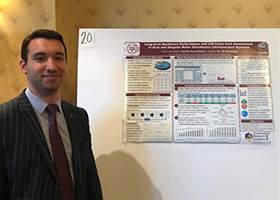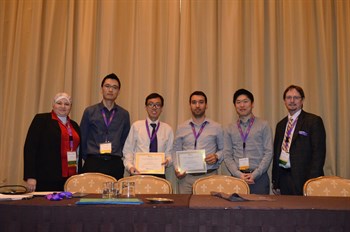Water is a resource that is not only in constant demand, but also has the power to cause catastrophic damage to urban communities. These communities need a resilient infrastructure as a resource in order to be adaptable and effective stewards of the resources.
 Texas A&M University Zachry Department of Civil Engineering doctoral student Kambiz Rasoulkhani has dedicated himself to studying the long-term resilience of water infrastructure systems in urban communities. He evaluated these communities using simulations based on current day data, creating projections on how resilient a community’s infrastructure might be over a period of 50 to 100 years in the future. The goal of his work is to see the effects of natural disasters on a city’s long-term infrastructure sustainability, work for which he was recognized at the 2018 American Society of Civil Engineers’ Construction Research Congress.
Texas A&M University Zachry Department of Civil Engineering doctoral student Kambiz Rasoulkhani has dedicated himself to studying the long-term resilience of water infrastructure systems in urban communities. He evaluated these communities using simulations based on current day data, creating projections on how resilient a community’s infrastructure might be over a period of 50 to 100 years in the future. The goal of his work is to see the effects of natural disasters on a city’s long-term infrastructure sustainability, work for which he was recognized at the 2018 American Society of Civil Engineers’ Construction Research Congress.
“I’m interested in applying technical and infrastructure solutions that can enhance the urban water infrastructure resilience on both the demand and supply side of water utilities,” said Rasoulkhani. “On the demand side, I attempted to identify pathways leading toward [increased] adoption of conservation technologies for water users like you and I, and on the supply side I examined the effectiveness of physical infrastructure solutions for the water utilities professionals who are making decisions on how the water infrastructure system is managed.”
In his research, Rasoulkhani used a simulation research approach, applying multi-agent based modeling to look at the long-term effects of the mechanisms underlying a water distribution infrastructure’s behavior. He has developed simulation models to capture long-term performance metrics based on data collected in cities across the country, such as Fort Collins, Colorado.
 “I’m not looking at just a single pipeline,” Rasoulkhani said. “I’m looking at the whole system in this, which is what is called a complex system approach. In looking at the data from Fort Collins, we can capture the dynamics of singular and dual water distribution systems and compare them over an extended 50-year horizon through simulation to understand all the dynamics and life cycle costs.”
“I’m not looking at just a single pipeline,” Rasoulkhani said. “I’m looking at the whole system in this, which is what is called a complex system approach. In looking at the data from Fort Collins, we can capture the dynamics of singular and dual water distribution systems and compare them over an extended 50-year horizon through simulation to understand all the dynamics and life cycle costs.”
Rasoulkhani believes these models can be used by the city decision makers to implement strategies that can improve or enhance the resilience of urban infrastructure systems and help short- and long-term recovery from disasters like droughts and floods. Moving forward, the next step in his research is to validate the findings of his study. He looks to expand his study to include costal water infrastructure resilience by evaluating areas like Miami, Florida that are more exposed to extreme weather events.
“My ultimate goal in all of this is to help in the creation of sustainable cities,” Rasoulkhani said. “For our future, we have to make sure that we will have access to more water, we have to make sure we have infrastructure that is resilient in order to be sustainable and thrive, and this is part of that answer."